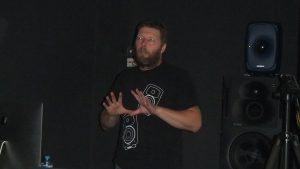Meeting Report – December 2018
Chairman Graeme Huon welcomed all to the meeting and introduced Steve Spurrier to present to us on the use of Digital Signal Processing in a range of Genelec monitoring loudspeakers, outlining Steve’s background and training in these specific Genelec models.

Steve started by highlighting the challenges of achieving monitoring loudspeaker accuracy in the crowded, acoustically challenged control rooms found in today’s diverse content creation environment.
He commented that modern monitoring loudspeakers from a range of manufacturers can be very accurate – to within +/- 2dB – when measured in an anechoic environment.
He then referenced a paper presented by Genelec at the 111th AES (2001) entitled “A Survey Study of In-situ Stereo and Multi-Channel Monitoring Conditions” which identified just how widespread the issues of speaker /room monitoring variations were.
The paper is available as a PDF here.
This paper is also available at the AES E-Library on aes.org.
He suggested that the use of equalization should only be the final step to optimize response, after any major room anomalies have been dealt with acoustically.
Steve then went on to describe the LF/MF/HF DIPSwitches which were the only corrective technique available on previous Genelec models to adjust the speaker response to better match the room and its position in it.
He then moved on to describe the evolution of Genelec’s loudspeakers to improve the in-room performance by the use of agile filters, where measurement identifies a specific problem, and the system can treat that problem. He described the SAM (Smart Active Monitoring) loudspeaker range, and the GLM (Genelec Loudspeaker Manager) software which is used to set up and control the SAM-capable loudspeaker systems, as well as AutoCal which is used to build the agile filters within the systems.
He then described the hardware elements of typical SAM-capable speaker systems, and followed this with a description of AutoCal, and how it can be used to compensate for LF and MF room anomalies, as well as applying delay to one side to optimize imaging. He also covered the challenges involved in the modern control room where additional equipment surfaces like computer and video monitors seem to be multiplying and increasing in size.
After demonstrating the operation of the GLM software and AutoCal, Steve played some music through his speakers (a pair of 8341s) to demonstrate the difference between the calibrated and non-calibrated audio on a range of music types.
As well as a range of questions from the audience during his presentation, Steve fielded several questions following his presentation, attesting to the audience’s keen interest in the topic.
We thank Steve for a most illuminating presentation, and also Deb Sloss from Studio Connections for her assistance with the arrangements.
The audio recording of Steve’s presentation can be heard or downloaded here.
(The music demo sections of this recording have been truncated)
A special thanks to The SAE Institute for the use of their excellent facilities.
